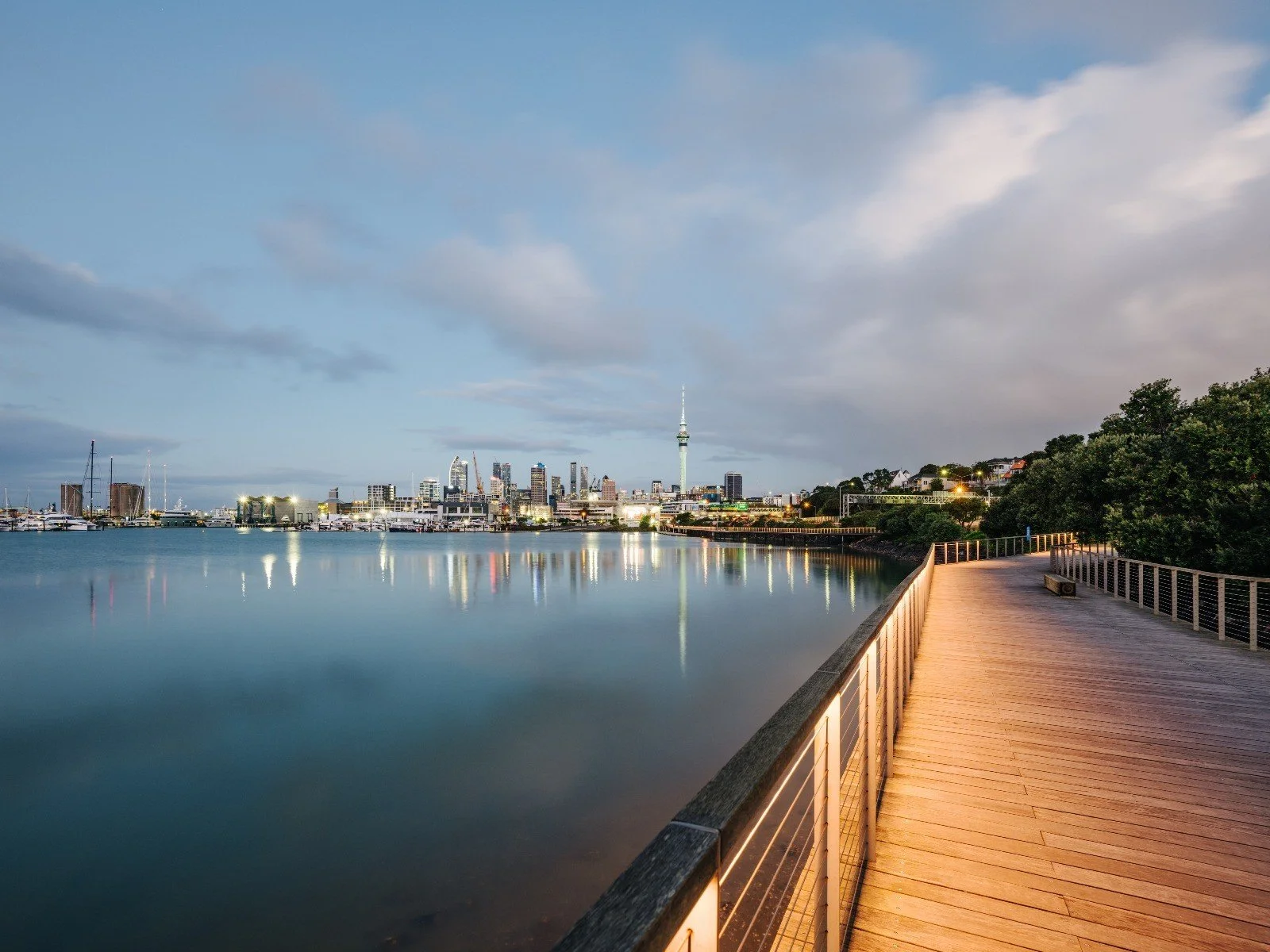
Businesses
Auckland's businesses
Proportion of businesses by size
Source: Infometrics: Regional Economic Profile
Average number of employees
Source: Infometrics: Regional Economic Profile
Tāmaki Makaurau Auckland has around 225,000 businesses. They employ more people on average than the rest of the country.
Auckland’s businesses come in a range of sizes. Around 160,000 have no employees at all, 37,500 have between one and five, and some have more than 10,000 – in fact, Auckland is home to over 60% of New Zealand’s top 200 companies. Auckland, like the rest of New Zealand, is mostly made up of small businesses, and the proportion of Auckland’s businesses that employ 50 or more people has fallen slightly since 2019.
The number of Auckland businesses continued to grow during COVID-19, by less than GDP growth but more than population. Initiatives such as the wage subsidy were an important support mechanism. While there is also no clear evidence in the data of an increase in ‘business deaths’ during the COVID period, the adverse impact of the pandemic on Auckland businesses should not be underestimated.
-
Auckland had approximately 225,000 businesses in 2023.
This is 11% higher than the 2019 value of 201,000.
The number of Auckland businesses grew at a slower rate than GDP from 2019 to 2023 (although closer to real GDP growth), but faster than population growth.
While COVID-19 adversely impacted many businesses, especially in industries like hospitality, retail and tourism, there was no clear increase in the number of ‘business deaths’ than during previous years.
Auckland currently contains 35% of all New Zealand’s businesses, compared with 33% of the population.
-
72% of Auckland’s businesses have no employees.
They are either sole traders, or contract out their labour.
This number has increased since 2019, and is slightly higher than that of the rest of New Zealand.
Of those businesses which employ staff, the average size is 16 employees.
Industries with the lowest number of employees per business unit are ‘rental, hiring and real estate services’, ‘agriculture, forestry and fishing’, ‘financial and insurance services’, and ‘construction’.
‘Public administration & safety’ and ‘education’ have the largest number of employees per business unit.
Source: Infometrics: Economic Regional Profile
Productivity
GDP per filled job (2023)
Auckland’s labour productivity is higher than the rest of New Zealand, reflecting its relative focus on high-value service industries.
Labour productivity represents the ability of the workforce to generate GDP, based on its own inherent productivity but also its ability to leverage capital resources.
Auckland generated $147,000 of GDP per employee in the year to March 2023. This is lower than Wellington, but higher than the rest of New Zealand, reflecting the differences in industry mix across the country. Labour productivity was higher, in real terms, in 2023 than it was in 2019.
Like New Zealand more generally, Auckland faces the challenge of increasing its productivity in the future, as productivity remains low in the region relative to international comparators. This will be a fundamental driver of whether real GDP per capita can continue to increase in the future.
-
Auckland’s average labour productivity (GDP per employee) was $147,000 in the year to March 2023 – 2.7% higher in real terms than the 2019 value of $143,000.
Auckland has higher productivity than the rest of New Zealand ($132,000). However it is lower than some other comparators, including:
Wellington ($156,000), which is less diversified and has a large government administration industry compared to Auckland. Auckland has higher productivity in several key service industries.
Many cities in other developed countries, such as Brisbane, Vancouver, Dublin and Copenhagen.
Auckland’s productivity growth in 2023 was 1.7%, while the rest of New Zealand’s was negative.
Auckland’s four most productive industries are also in the top six most capital-intensive industries in the country.
-
Auckland’s most productive industries are ‘information media and telecommunications’, ‘rental, hiring and real estate services’ and ‘financial and insurance services’.
All three of these industries are more productive in Auckland than in the rest of New Zealand.
The fastest recent productivity growth since 2019 has occurred in the ‘information media and telecommunications’ industry (26%).
Auckland is New Zealand’s tech hub. It is home to 116 of New Zealand’s top 200 tech companies. Auckland tech firms are highly productive – in 2022 they employed 2.0% of Auckland’s workforce, but accounted for 6.4% of GDP. They spend 10% of their earnings on R&D – much higher than the average across the New Zealand economy (1.4%).
Sources: Labour productivity, GDP per filled job – Infometrics: Regional Economic Profile. Retail growth – Auckland Council: Monthly Economic Update and StatsNZ: Quarterly Retail Trade Survey International comparators – Stats
OECD: Productivity and ULC. Technology industry – 2023 TIN report and 2023 TAU insights report on the tech sector
Pakihi Māori (Māori-owned businesses)
Top 8 industry GDP contributions for Māori Business in Tāmaki Makaurau Auckland (2020)
Proportion of total value added by business size
Te Ōhanga Māori (the Māori economy) in Tāmaki Makaurau Auckland, which encompasses the broader economic activities of all Māori, and Pakihi Māori (Māori-owned businesses), referring specifically to Māori-owned businesses, plays a critical role in our region’s overall economic landscape.
Māori are integrated throughout all areas of the economy, from tech and creative industries to climate innovation. Despite facing consistent and systemic challenges, Māori are excelling in various fields, demonstrating remarkable resilience and innovation.
Specific to Pakihi Māori, the largest industries are construction and wholesale trade, which suffered significant impacts through the COVID period, via supply chain constraints and labour shortages. Tāmaki Makaurau Auckland has more Pakihi Māori and iwi assets in professional services than the rest of Aotearoa New Zealand, and less in primary industries. Tourism is also an important industry, and was severely affected by border closures during COVID-19.
-
Te Puni Kōkiri defines Māori businesses as those which are at least 50% owned by Māori (self-defined ethnic group and Māori descent) and includes sole traders (all Māori individuals with any self-employed income).
The definition of what constitutes a Māori business can vary, and different research has defined and identified Māori businesses in different ways. The Te Puni Kōkiri definition informed the 2022 Tāmaki Makaurau Māori economy report published by the Southern Initiative (Auckland Council).
Approximately 7% of businesses in Auckland are Māori businesses (using the above definition).
This includes around 11,500 sole traders and 5100 larger businesses (16,600 businesses in total).2
While 22% of New Zealand’s Māori businesses are in Auckland, they account for 26% of GDP contribution by Māori businesses nationally.
The largest (by GDP) industries for Māori businesses in Auckland are ‘construction’, ‘wholesale trade’, ‘professional, scientific and technological services’, ‘administration & support’ and 'transport, postal & warehousing’.
Construction represents 32% of all Auckland Māori businesses, and generates 21% of Māori businesses’ contribution to Auckland’s GDP. These businesses tend to be smaller, with an average of 4.5 employees.
2. The updated Te Matapaeroa 2021 (Te Puni Kokiri 2024) report has applied a stricter definition to count sole traders, including only those which are considered ‘established’. This reduces the number of Māori sole traders from 11,500 to 2500.
-
Māori businesses employ 14% of all Māori employees in Auckland, despite representing only 6.5% of the number of businesses.
Smaller Māori businesses tend to employ proportionately more Māori employees than large businesses do.
During COVID, half of Māori small and medium enterprises (SMEs) were considered essential. These were mainly in ‘agriculture, forestry and fishing’, ‘manufacturing’ and ‘health care and social assistance’.
Pakihi Māori bring unique benefits and characteristics to Tāmaki Makaurau Auckland’s economy. They are strongly values-oriented, balancing social, cultural, environmental, spiritual and economic goals.
While the mix of sizes of Māori businesses is similar to non-Māori businesses, the smaller businesses provide more of the GDP contribution (and the larger businesses less) than is the case for non-Māori businesses.
The number of Māori businesses in Auckland is growing, but by less than total business growth. Furthermore, Māori businesses are employing 11% fewer workers than they were in 2010, compared to 42% more for non-Māori. Retaining a significant Māori business presence in Auckland will require that trend to be reversed.
To close the self-employment gap between Māori and non-Māori, research shows that access to capital, as well as education, know-how and skills gaps, need to be addressed.
-
The size of Māori businesses in Auckland are proportionately very similar to non-Māori businesses.
The majority of businesses are small, with nearly 70% employing five or less people. Māori businesses are, however, less likely to employ 100+ people.
Small Māori businesses contribute a greater share of Māori business GDP, relative to small non-Māori businesses’ share of non-Māori GDP.
This is influenced by the GDP share of the largest businesses – very large Māori businesses do not contribute as much GDP as very large non-Māori businesses.
Employment in Auckland Māori businesses fell by 11% from 2010-20, while employment in Māori businesses across the rest of Aotearoa New Zealand increased by 14%.
-
The number of Māori businesses in Auckland has grown from 2010-2020 (5.5%). However, this is slower than the growth over the same period, of:
non-Māori business numbers (25%)
Māori business numbers across the rest of New Zealand (11%).
GDP contribution from Auckland Māori businesses declined between 2015-2020, meaning the gap between Māori and non-Māori businesses is widening.
In some industries, Māori businesses appear to be outperforming non-Māori businesses in terms of their contribution to Auckland’s GDP, relative to their income.
Sources: The Southern Initiative (Auckland Council): Data snapshot: Tāmaki Makaurau Māori economy. Te Puni Kōkiri: Te Matapaeroa 2020 and 2021
Auckland Economic Monitor
A summary of key economic information about the region
Auckland’s economy: What’s changed?
Deep dives
Cost of living
Inflation reached levels not seen since the 80s in 2022 and remains above historical levels.
Investment & trade
Auckland plays a significant role in the country’s investment and trade landscape.
Auckland’s industrial employment areas
Trends over the last two decades.













